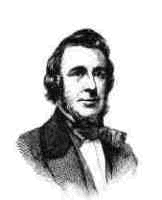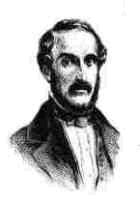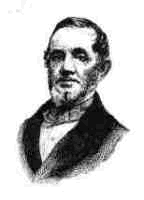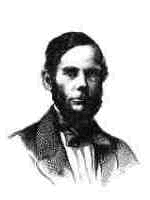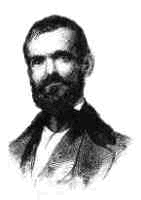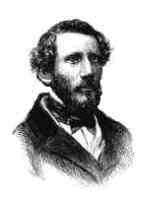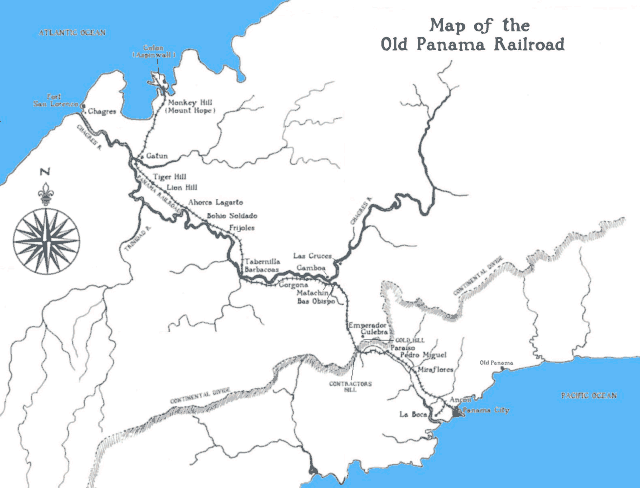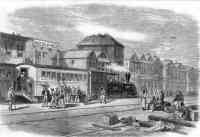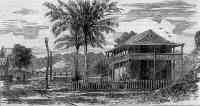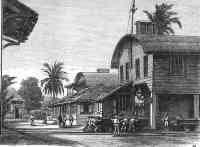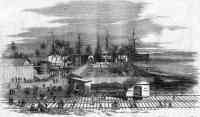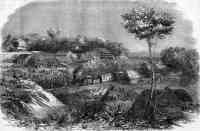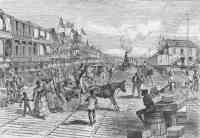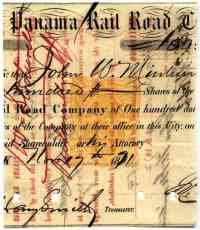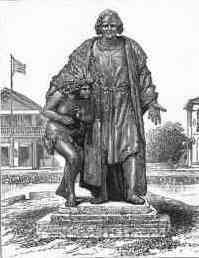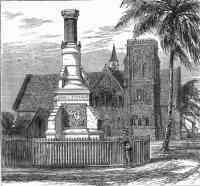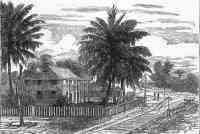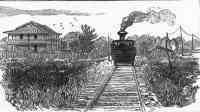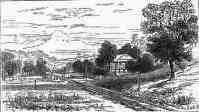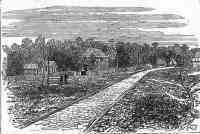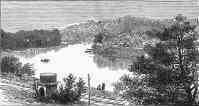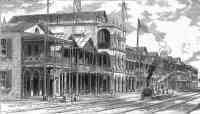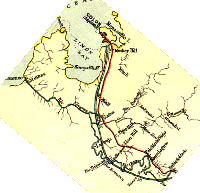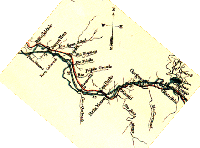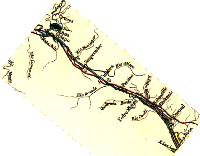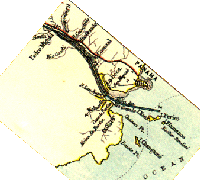Panama Railroad
| The desire for a route, across the isthmus of Central
America, was needed early in the 18th century. England want to build
some kind of connection, between the Atlantic Ocean and the Pacific,
shortening the trade routes to her Far East Colonies and possessions.
After studying the possible routes, across the Central American
Isthmus, decided that it would be too expensive, and abandoned the
idea. She went as far as securing treaties and agreements with
Colombia.
France also entered into agreement with the government of Nueva Granada (Colombia and Panama) in 1831 and 1848, to build a railroad across the isthmus. But, again, the huge cost was an obstacle, and the project was never started. |
||||||||||||||
The discovery of gold in California in
1849, rekindled
the need for some way to make the trip from the east coast of the
United States, to the west coast shorter. At the time, the only way
for somebody wanting to go from New York to California, was:
|
||||||||||||||
| After the breakaway of Central America from Spain, in 1852, an American entrepreneur, O. W. Childs, was awarded a contract to build a route in Nicaragua. Part of it was to be by river, and the rest by road, that he was to construct. | ||||||||||||||
| The US Congress saw the need for a mail route from
the East Coast to California and Oregon on the West Coast. Hoping to seed up the construction of
a route, authorized the establishment of two mail steamship lines. One
would connect New York and New Orleans to Panama, on the east coast.
The other would connect Panama via the isthmus, to California and
Oregon, on the west coast. William H. Aspinwall secured the rights for
the line on the Pacific, which included the isthmus portion. George
Law was awarded the contract for the Atlantic route.
Aspinwall and his associates, John L. Stephens and Henry Chauncey, secured a contract with Nueva Granada (later to be renamed, Colombia), for the construction of "Iron Road, across the Isthmus of Panama". They requested concession from Nueva Granada, as early as 1848. They also secured the help of the US Topographical Corps, and the service of G. W. Hughes, to do a survey and mapping of the best route, and feasibility. They reported that a railroad was practical and corroborated Stephen's and Aspinwall's opinions. Aspinwall immediately returned to New York, and the three partners incorporated the Panama Railroad Company, in 1850, with a fixed capital of $5,000,000 and all the stock (at $100 a share) was quickly sold.. They were granted exclusive rights to build the railroad by the government of Nueva Granada. On April 15, 1850, a concession was signed by Secretary of State of Nueva Granada, Don Victoriano de Diego Paredes and John L. Stephens. This railroad was to connect the old, colonial city of Panama, on the Pacific coast, with some point on the Caribbean coast. This contract granted them six years to build the railroad, and then gave them forty-nine years to run it after it was completed. There was a inclusion in the contract that if after 20 years, Nueva Granada wanted, they could buy the railroad for $5,000,000, the amount was the same that was projected for the cost of the railroad, and the same as the initial stock offering.
Originally, the Atlantic terminus was thought to be Porto Bello. This old town, the only town of significance on the Atlantic coast, was located in a well protected harbor, with excellent deep water anchorage It had been originally discovered by Columbus on his fourth voyage of discovery, on November 21, 1502. The Spanish had constructed a pave highway between Porto Bello and Panama, some 50 miles away. This road was used to transport the treasures of the Incas, across the Isthmus, and then to Spain, on the Treasure Fleet. The reason, Porto Bello was not used as the Atlantic terminus, was that George Law, of New York, hearing of the project, proceeded to buy all of the land available, at a low cost. He then offered it to the fledgling company, at an inflated price, which they could not afford. The Panama Railroad Company, and George Law, were never able to arrive at an acceptable price, and the decision was made to construct the terminus else where. The next site selected, was referred to as "El Otro Lado", the other side of Porto Bello, at Navy Bay, at Keeny's Bluff, close to the present side of the city of Colon. This had the advantage that they would be constructing on solid ground, not in the swamps that surrounded the area, and there was plenty of fresh water available. From there, they could take the railway to the Mindi River, keeping on solid ground. This second site was recommended by many local inhabitants of Panama, most prominent being, Mr. de Sabla. This site was overruled to another site, close by, which offered deeper water. The mouth of the Chagres River, as another site that was rejected, due to the poor port facilities there. The Spaniards used the Cruces Trial route for years, after they stopped using the road to Porto Bello. They preferred this route, since it was faster. They went by mules or foot to the town of Cruces on the Chagres River. They then went down river to the Caribbean in canoes, and then sailed to Porto Bello. There were reefs and sandbars at the mouth of the river, and no harbor for the protection of ships during storms. The engineers selected a route that crossed the isthmus at its lowest and shortest point. They decided to start the Atlantic terminus in a marshy spot on the island of Manzanillo, in Limon Bay, and cross the coastal plain ascending to the mountains, and then descending to the narrower costal plain in the Pacific city of Panama. The survey of the site, was directed by the Railroad Company's chief surveyor, James L. Baldwin and Col George W. Hughes of the United States Topographical Corps. Col. Hughes was a distinguished Army Engineer, sent to Panama at the request of Aspinwall and Stephens. They laid out the route to follow, and found the lowest place to summit the railroad. Captain John Jay WIlliams, Col Hughes assistant, set the first stake, to indicate the beginning spot for the railroad, in the winter of 1849. He wrote that the team went from the mouth of the Chagres River, in the small steamer "Orus", to the site of the future town of Aspinwall. After walking around the island, the found the spot where they wanted to start the construction. The engineers hired for the job were Col. G. W. Totten and John C. Trautwine. They had actually been contracted to do the job, but when they arrived in Panama and saw the difficult task ahead, asked that their contracts be withdrawn. The company did so, and decided that the company would do the job, but hired Totten and Trautwind to supervise the project. The work began in May, 1850, with no fanfare or ceremony. Totten and Trautwine, and some of the native Indians hired to do the job, began by attacking the jungle with machetes and axes. The first 13 miles of the route, consisted of marshes, swamps, and thick, impenetrable jungles. James Baldwin had the responsibility of laying out the line where the tracks were to run. His team had to wade in water, waist deep, for a distance of two miles before they reach dry land. This low hill is the site where there is now a cemetery, and just beyond it, they were back in waist deep water again. Baldwin carried his lunch in his hat, during the trip through the swamp. They did clear some land to erect shelter for the protection of the supplies, and themselves from the rain. They also had to contend with the large number of mosquitoes, which made life miserable. During the first couple of months, they had to live on board the ships, since out in the bay, they were better protected from the mosquitoes. By 1849, gold seekers, bound for California, were already disembarking at the mouth of the Chagres River. The need to finish the railroad as soon as possible, was apparent, and there was hope that it would be completed by 1852, and contracts were negotiated, with that in mind. Unfortunately, the true cost of the construction was not realized, before the work began. They had no idea, what it would be like, to construct a railway across the swamps, endure the constant rains, and fight the tropical diseases that were constantly claiming the lives of the workers. All of their supplies and stores, had to be shipped from the United States, as there was very little of it in Panama. They even had to bring most of their food from the United States. The natives, unaccustomed to the fast pace, the Americans wanted, refused to work on the job, and the builders found themselves importing labors from different parts. English, Irish, Germans, Chinese were brought to the tropics, and they would soon die from Malaria and Yellow Fever.
There was a belief among the workers, that for every cross tie on the tracks, one person died. This of course, is not true, since if you calculate how many cross ties, there are (approximately 2,000 per mile, or 50 X 2,000) 100,000 cross ties, or 100,000 deaths. There were never more than 6,000 workers used during the construction. The death rate was high, with approximately less than 40% of the workers succumbing to diseases. Very few of the workers died of the so-called Chagres Fever, (Malaria), since Quinine Sulfate, had been in use for hundreds of years, and was plentiful in Panama. By October 1, 1851, the line extended as far as Gatun, a town located only 7 miles from Manzanillo and on the Chagres River. By then there was a train that was making that round trip, several times a day. This train was busy carrying workers and supplies to the work site. At the same time, they were also busy building docks in Limon Bay and housing and roads on Manzanillo Island. In November, two steamships, the Georgia and Philadelphia full of Argonauts, on their way to the gold fields in California arrived. The passengers were to debark at the mouth of the Chagres River, and continue their journey up the river by Cayucos and small boats. Fortunately for the struggling railroad, the weather was bad, and the seas rough. The ships were not able to get as close to land as they wanted, and some people drowned in their attempts to reach land. The ships were force to take refuge in Limon Bay, and the new docks being built for the train. Somebody suggested that they put some Flat Cars on the train and transport the passengers to Gatun, and from there, start the trip up the Chagres. Once the reached the town of Gorgona or Cruces, they would go by land, walking and riding mules or horses over the Las Cruces Trail to Panama. This event, gave the company a big shot in the arm, and provided a means of generating revenue, while the work was in progress. The original million dollars, raised was almost gone and it was hard to generate interest in investing funds. Everybody was getting discouraged because the work was progressing so slowly, and the death toll kept going rising. With this new influx of money, a total of $2,000,000 over the course of the construction of the line, excited investors and they started putting more money into the project. Has news of the new train service in Panama began to circulate in the US, more passengers took the Panama route and more funds were generated by the railroad. Especially has the line extended farther and farther, across the Isthmus. On February 2, 1852, the town on Manzanillo was incorporated and named Aspinwall in honor of the originator of the road. By March, 1852, regular passenger train service was running 16 miles from Aspinwall. By July, the lines had been laid to the town of Barbacoas, 23 miles from Aspinwall. At this time, there were ships going around Cape Horn, carrying supplies and men, to begin the construction, from Panama. On October 10, 1852, John L. Stephens, the president of the company died and W. C. Young succeeded him, as president of the company. With Stephens death, things looked bleak for the company. He was a hands on man, and worked very diligently, along with the men in Panama. When he was too sick to continue working, he went to New York, where he died soon after. A new contractor had been secured to finish the railway, from Barbacoas to Panama. At Barbacoas, they started to build a 300 foot bridge across the Chagres. At this point, the river had been know to rise over 45 feet, in a couple of hours, after heavy rains. When the bridge was nearly completed, one span was washed away in a great flood. This was another major delay for the railway. Work on the bridge was very slow, and after a year, it was had not been completed. The contractor working on the bridge, went bankrupt and the company took over the work. At this time, a new president had been appointed for the company, David Hoadley. Colonel A. J. Center was appointed vice-president, and then sent to Panama to become the resident superintendent of the enterprise. When he arrived on the Isthmus, the work was restarted with great vigor. In January 27, 1855, at midnight and in the rain, the line reached the top of the continental divide at Summit (now called Culebra), about 37 miles from Aspinwall and 10 from Panama. Here, the work stopped, to wait for the line that was being constructed from Panama City. The line from Panama, under the supervision of J. Young, was only 10 miles long, and the workers did not have swamps to build through. At midnight, on January 27, 1855, during a large rain storm, the last rail was laid, and the road finished. The next day, amid much fanfare, a train went from coast to coast. The railroad was completed at a final cost of $7,000,00 or $140,000 per mile, making it the most expensive railroad ever built. The distance of the railway was 47 ¾ miles long. It had 170 bridges and culverts, one of the bridges was over 600 feet long. There was no tunneling, no rock cutting of any importance, and no heavy grading. The summit grade was 258 feet above sea level.
Once the line was completed, the company could not stop it work. Up to then, the spent most of their energy in building the line. Once completed, they now had the job of making things permanent. Wooden bridges, hastily erected, had to be replaced with Iron bridges. Trestles had to be converted to more permanent embankments. The original ties, made from local lumber, was already decaying, and had to be replaced with harder wood. The new ties came from Colombia and were made of lignumvitae, a timber so hard that they had to drill the ties, before spikes could be nailed. These ties, were so good, that in 1910, during the construction of the canal, the lines were moved, and the ties were found to be in perfect condition. The cost of using the railroad was established at $25,00 one-way for passengers First Class, or $10.00 for Steerage. The first passengers, paid $5.00 for the ride to Gatun. Personal baggage was charged at the rate of 5¢ per pound. Freight rates were established at $1.80 per cubic foot for express, 50¢ per cubic foot or First Class and $1.50 per 100 pounds of Second Class. Mail was transported at 22¢ per pound and Coal was transported at the rate of $5.00 per ton. These rates, made it the most expensive railroad in the world. It cost $8,000,000 to build the railroad, not the $5,000,000 as originally estimated. The line had generated $2,000,000 before it was completed from Aspinwall to Panama. Ten years later, by January 1865, it had generated $11,340,000 in profits. It frequently transported over 1,500 passenger in a single day. It moved the US Mail and the freight of three steamship companies. The company treated its employees very well, and maintained a patriarchal relationship with them. Since there was not much to Panama, at the time, the company provided everything to its employees. The food they ate and the houses they lived in, was all provided as part of their contract, when the moved to Panama. The company provided free hospitalization, with competent physicians on hand. They provided a well stocked library, with billiard parlors, and churches for the workers. In 1867, Colonel Tottem went to Nueva Granada, to negotiate a new contract. Since the original one, allowed Nueva Granada to buy it after 20 years from the time it was completed for $5,000,000. The Panama Railroad Company had a goose that laid golden eggs, generating 24% on the $7,000,000 investment, and they did not want to lose it. He negotiated a new contract the was signed on August 16, 1867 by the president of Nueva Granada, Santos Acosta and G.M. Totten. The company was granted the rights for 99 years. paid the government $1,000,000 in gold, $250,000 a year, transport all Nueva Granada mail for free, and continue the line to include some islands (Naos, Culebra, Perico and Flamenco) off the coast of Panama. The extension of the line to these islands was desired, since Panama City, lacked a deep water. Ships would dock at Taboga, or Perico and passengers and freights was transported by shallow draft boats to the larger ships docked in deep water. Another item in the new treaty, returned the Island of Manzanillo, back to Colombia, and strengthen their demand, that the town of Aspinwall, get renamed, Colon. When the conditions of the new contract reached New York, the stock price dropped from around 300 points to 80, in a single week. |
||||||||||||||
|
The trip across the isthmus of Panama, became much easier when the Panama Railroad
Company was completed in 1855. Between 1855 and 1869, the railroad transported tens of thousands of
forty-niners heading west to the gold fields in California. It also
transported them back east, with all of their gold, from California. The importance of the line lessened after
May 10, 1869 when the
United States completed its transcontinental railroad.
Although the California traffic was lost, it was not as significant for the Panama Railroad, as originally believed. At the time, the population of California was estimated at 500,000, while the estimates for the population of Central America, was 2,000,000 and that of the Pacific coast of South America was estimated at 8,000,000. The combined population of 10,000,000, the California traffic only amounted to 1/20 of the traffic of the line. But the decline of the Panama Railroad was due to other consequences. For some time, the shipping companies that made use of the Panama Railroad, were complaining about the outrageous cost of transporting freight. The Pacific Steam Navigation Company had 12 steamships running twice a month, between Panama and Valparaiso in Chile. They maintained a large coaling station and shipyards in Taboga, and had been shipping its coal by train, and asked for a reduction in rates. The Panama Railroad Company, would not think about it, and refused any reduction in rate. Therefore, in 1868, the Pacific Steam Navigation Company started service from Liverpool to Valparaiso, sending its freight and coal around the Straights of Magellan. They also transferred it coaling operations and shipyards to Callao. By 1874, they had added more ships to the line, and had 54 steamers sailing between England and South and Central America. The railroad lost a good source of revenue because its directors were inflexible, and had the attitude that its rates, established when the demand was great, were non-negotiable. In 1966, a new shipping line was established between Panama and Australia. The Panama, New Zealand and Australian Steamship Company had 4 steamers that made the monthly route between Panama and the South Pacific. They also requested rate reductions with the Panama Railroad Company, but the directors would have nothing of it. They would not even reduce their rates, for the first year, enough time for the shipping company to establish itself. The company eventually went under, and the Panama Railroad lost another opportunity to make money. The railroad still transported passenger and freight between the Atlantic and Pacific. The company sold the line, stock, and rights to the Compagnie Universelle du Canal Interoceanique for $18,000,000. |
